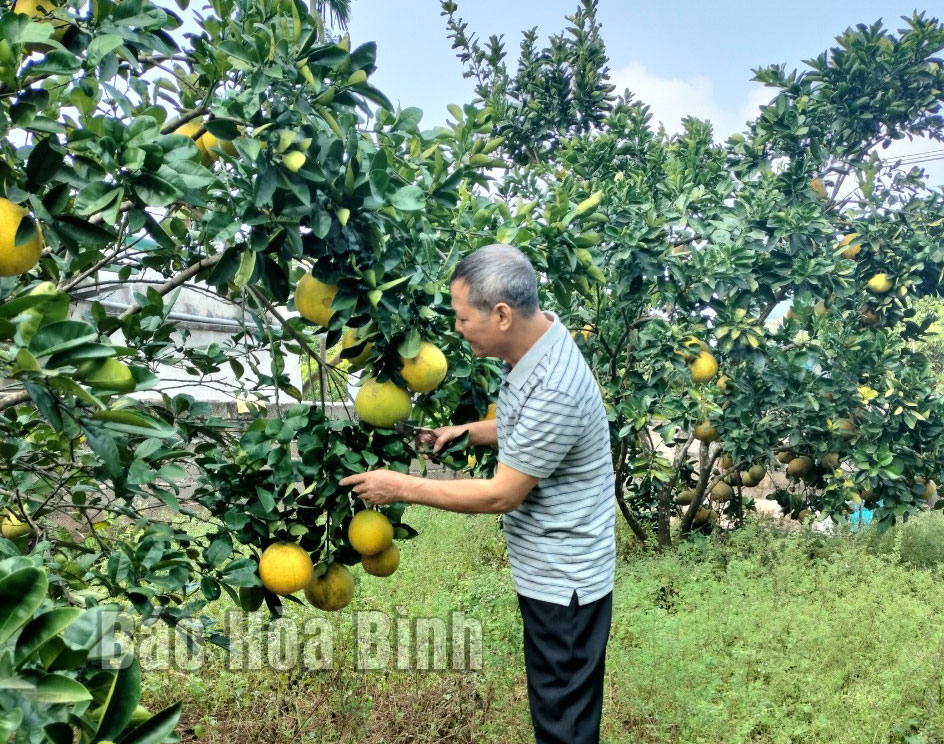
(HBO) – On these days, grapefruit growers throughout the Muong Bi region begin entering a new harvest season. Thanks to the active application of scientific and technological advances, proper care and favourable weather, the quality of grapefruit is increasingly improved. This year, local growers have taken advantage of social networks and online sales methods to actively find markets, with hope for a good harvest and stable prices.

Farmer in Dong Lai commune (Tan Lac) harvests
red-flesh grapefruit at the beginning of the season.
As the harvest season comes, the Tan Dong organic grapefruit
growing and service cooperative promote its role in connecting, finding
markets, and ensuring product sales for its members.
Tran Hong Nang, director of the cooperative said after the
COVID-19 pandemic, cooperative members have been more proactive and responsive
in coordinating and uniting to find markets and make most of online sales
channels on zalo and facebook social network platforms, and e-commerce trading
platforms to reach more potential customers. They have also been equipped with
knowledge and legal regulations on the production and business of safe
agricultural products and food; and guided with experience on production and
business models and processes and linkages to produce and consume safe
agricultural products and food.
Grapefruits of cooperative members are all grown in
accordance with VietGAP standards, he said, adding that the fruit is also a
provincial 3-star OCOP (one commune-one product) product, with a traceability
stamp and contained in a box printed with full information, the address of the
place of production. Therefore, this fruit is chosen by many customers, traders
and clean agricultural product shops in big cities such as Hanoi and Ho Chi
Minh City, when the harvest season comes.
Tan Lac district currently has over 1,500 hectares of citrus
trees, including over 1,100 hectares of grapefruits of all kinds grown in most
communes and towns. Bui Van Hien, head of district Department of Agriculture
and Rural Development, said that over the years, grapefruit trees have affirmed
their value, contributing to the socio-economic development of the district.
The district has many areas certified with VietGAP. To enhance the value and
preserve the local grapefruit brand, the district continues to effectively
implement brand management, maintain the supply of traceability stamps, use
packaging for units and cooperatives that meet standards./.
Hoa Binh province is undergoing a dynamic transformation amid Vietnam’s national digital transition. Building on Poliburo’s Resolution No. 57-NQ/TW on breakthroughs in science, technology, innovation, and national digital transformation, the province has rolled out a wide range of practical action plans. A standout initiative is the "Digital Literacy for All” movement, an effort to ensure that no one is left behind in the digital era.
Hoa Binh province is undergoing a dynamic transformation in the wake of the national digital transformation movement. Building on Resolution No. 57-NQ/TW of the Politburo on breakthroughs in science, technology, innovation, and national digital transformation, the province has implemented a wide range of practical action plans. A standout initiative is the "Digital Literacy for All” movement ambitious effort to ensure that no one is left behind in the digital age.
With a spirit of unity and proactive problem-solving, the Party Committee, the government and the people of Dong Lai Commune (Tan Lac District) have made great strides in implementing the resolutions of the 24th Party Congress of the commune for the 2020 - 2025 term. Focusing on leadership and practical actions, the commune has brought the Party’s resolutions into daily life, creating strong impacts and pushing the local development forward.
Amid the nationwide push for digital transformation, young people in Hoa Binh Province are stepping up as dynamic pioneers, applying technology to enhance Youth Union operations and expand the reach of youth-led initiatives. Through creativity and adaptability, Youth Union organizations at all levels have introduced a series of practical solutions, contributing to modern governance and community development.
In recent years, An Nghia commune, located in Lac Son district, has stepped up administrative reform, focusing on improving the quality and efficiency of its single-window service unit for receiving and processing administrative procedures. These improvements have helped create favourable conditions for local residents and organisations to handle administrative procedures, contributing to the commune’s broader socio-economic development.
The Prime Minister-approved master plan to develop the multi-use value of forests ecosystems through 2030, with a vision to 2050, aims to improve the management and sustainable use of forest resources, create jobs, increase incomes, and improve the living standards of ethnic minorities, people in mountainous and remote areas, forest workers and those living near forests.



